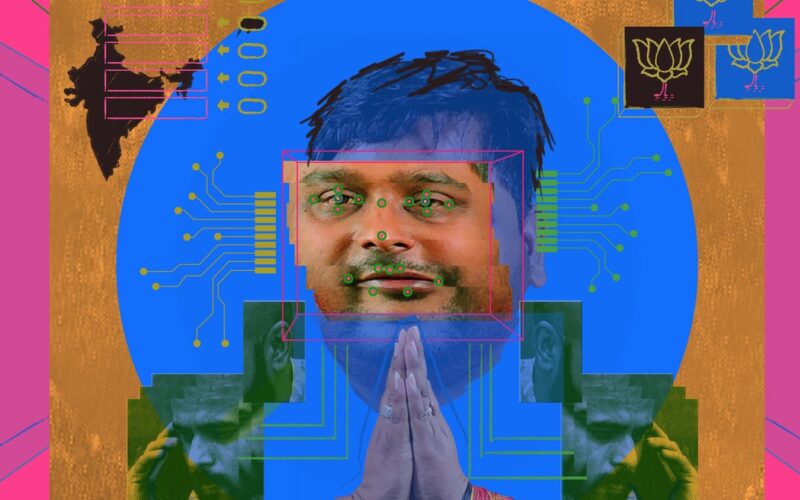On a stifling April afternoon in Ajmer, in the Indian state of Rajasthan, local politician Shakti Singh Rathore sat down in front of a greenscreen to shoot a short video. He looked nervous. It was his first time being cloned.
Wearing a crisp white shirt and a ceremonial saffron scarf bearing a lotus flower—the logo of the BJP, the country’s ruling party—Rathore pressed his palms together and greeted his audience in Hindi. “Namashkar,” he began. “To all my brothers—”
Before he could continue, the director of the shoot walked into the frame. Divyendra Singh Jadoun, a 31-year-old with a bald head and a thick black beard, told Rathore he was moving around too much on camera. Jadoun was trying to capture enough audio and video data to build an AI deepfake of Rathore that would convince 300,000 potential voters around Ajmer that they’d had a personalized conversation with him—but excess movement would break the algorithm. Jadoun told his subject to look straight into the camera and move only his lips. “Start again,” he said.
Right now, the world’s largest democracy is going to the polls. Close to a billion Indians are eligible to vote as part of the country’s general election, and deepfakes could play a decisive, and potentially divisive, role. India’s political parties have exploited AI to warp reality through cheap audio fakes, propaganda images, and AI parodies. But while the global discourse on deepfakes often focuses on misinformation, disinformation, and other societal harms, many Indian politicians are using the technology for a different purpose: voter outreach.
Across the ideological spectrum, they’re relying on AI to help them navigate the nation’s 22 official languages and thousands of regional dialects, and to deliver personalized messages in farther-flung communities. While the US recently made it illegal to use AI-generated voices for unsolicited calls, in India sanctioned deepfakes have become a $60 million business opportunity. More than 50 million AI-generated voice clone calls were made in the two months leading up to the start of the elections in April—and millions more will be made during voting, one of the country’s largest business messaging operators told WIRED.
Jadoun is the poster boy of this burgeoning industry. His firm, Polymath Synthetic Media Solutions, is one of many deepfake service providers from across India that have emerged to cater to the political class. This election season, Jadoun has delivered five AI campaigns so far, for which his company has been paid a total of $55,000. (He charges significantly less than the big political consultants—125,000 rupees [$1,500] to make a digital avatar, and 60,000 rupees [$720] for an audio clone.) He’s made deepfakes for Prem Singh Tamang, the chief minister of the Himalayan state of Sikkim, and resurrected Y. S. Rajasekhara Reddy, an iconic politician who died in a helicopter crash in 2009, to endorse his son Y. S. Jagan Mohan Reddy, currently chief minister of the state of Andhra Pradesh. Jadoun has also created AI-generated propaganda songs for several politicians, including Tamang, a local candidate for parliament, and the chief minister of the western state of Maharashtra. “He is our pride,” ran one song in Hindi about a local politician in Ajmer, with male and female voices set to a peppy tune. “He’s always been impartial.”
Jadoun also makes AI-generated campaign songs, including this one for local politician Ram Chandra Choudhary in Ajmer. Translated into English, the lyrics read: “For Ajmer, he brought a new gift / His name is Ram Chandra / He helps everyone / He was the president of Ajmer Dairy / He has always been impartial / He has Ram in his name / He is our pride / He’s a soldier of the Congress / Shares public anguish / Son of Ajmer / A guardian of development / Son of Ajmer / True form of development / Fight for everyone’s rights / Ram Chandra played the clarinet.” Audio: Divyendra Singh Jadoun
While Rathore isn’t up for election this year, he’s one of more than 18 million BJP volunteers tasked with ensuring that the government of Prime Minister Narendra Modi maintains its hold on power. In the past, that would have meant spending months crisscrossing Rajasthan, a desert state roughly the size of Italy, to speak with voters individually, reminding them of how they have benefited from various BJP social programs—pensions, free tanks for cooking gas, cash payments for pregnant women. But with the help of Jadoun’s deepfakes, Rathore’s job has gotten a lot easier.
He’ll spend 15 minutes here talking to the camera about some of the key election issues, while Jadoun prompts him with questions. But it doesn’t really matter what he says. All Jadoun needs is Rathore’s voice. Once that’s done, Jadoun will use the data to generate videos and calls that will go directly to voters’ phones. In lieu of a knock at their door or a quick handshake at a rally, they’ll see or hear Rathore address them by name and talk with eerie specificity about the issues that matter most to them and ask them to vote for the BJP. If they ask questions, the AI should respond—in a clear and calm voice that’s almost better than the real Rathore’s rapid drawl. Less tech-savvy voters may not even realize they’ve been talking to a machine. Even Rathore admits he doesn’t know much about AI. But he understands psychology. “Such calls can help with swing voters.”
Brushing shoulders with politicians isn’t new for Jadoun. He used to be one. In 2015, he stood for election in Ajmer as district president of the National Students Union of India (NSUI), the youth wing of the Indian National Congress, the once formidable national party that’s now the chief opposition to Modi’s BJP.
Source link
lol

